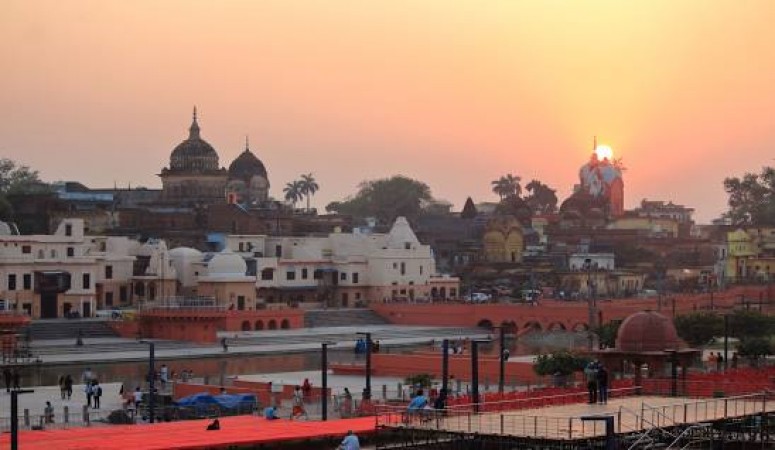
Ayodhya, a city located in the northern state of Uttar Pradesh in India, holds great significance in Hindu mythology. An ancient town, Ayodhya is regarded as one of the seven sacred cities of the Hindus, revered as the birthplace of Lord Rama, Ayodhya has a rich and ancient history that intertwines with the epics of Hinduism. According to Ramayana Ayodhya was founded by Manu the progenitor of mankind. Ayodhya, the legendary city of Hindu mythology, occupies a special place in the hearts of devotees. Its connection to Lord Rama and the epic Ramayana has made it an emblem of righteousness, valor, and devotion. As pilgrims continue to visit Ayodhya, seeking spiritual solace and inspiration, the city's mythological essence lives on, connecting generations to the timeless tale of Lord Rama and the glory of Ayodhya.
ALSO READ - Badrinath and Kedarnath: Majestic Spiritual Retreats in the Himalayas
Ayodhya is celebrated as the birthplace of Lord Rama, the seventh avatar of Lord Vishnu, according to Hindu belief. As per the epic Ramayana, Ayodhya was the capital of the kingdom ruled by King Dasharatha, Rama's father. Lord Rama's birth in Ayodhya marked the beginning of a divine journey that has left an indelible mark on Hindu culture and spirituality. The Ramayana, one of the two major Sanskrit epics of ancient India, showcases the life and adventures of Lord Rama. It narrates the story of Rama's exile, his battles against the demon king Ravana, and his eventual return to Ayodhya to reclaim his rightful place as the king. Ayodhya plays a pivotal role in the Ramayana, serving as the backdrop for various significant events, including Rama's marriage to Sita and the grand coronation ceremony. Valmiki, the sage-poet credited with composing the Ramayana, vividly described Ayodhya's splendor in his epic. According to Valmiki, Ayodhya was a magnificent city adorned with opulent palaces, beautiful gardens, and bustling markets. Its inhabitants lived in harmony, and the city was governed by principles of righteousness and justice. Valmiki's portrayal of Ayodhya elevated its status as a model kingdom, symbolizing an ideal society.
Ayodhya's significance extends beyond the events of the Ramayana. According to Hindu cosmology, Ayodhya existed in the Treta Yuga, the second of the four ages (Yugas) that make up a cycle of time. During this era, Ayodhya prospered under the wise rule of King Dasharatha and his successors. It was a time of virtue, righteousness, and the presence of divine beings, making Ayodhya a realm of spiritual enlightenment. Several ancient texts, including the Ramayana, Bhagavat Purana and Padma Purana, mention that the legendary Ayodhya was located on the banks of the Sarayu River, just like the modern Ayodhya. Several ancient texts, including the Vishnu Smriti and the Matsya Purana mention Ayodhya as a place of pilgrimage. The 1092 CE Chandrawati inscription of the Gahadavala king Chandradeva mentions that he took bath on the Svarga-dvara tirtha situated on the confluence of the Sarayau and the Ghaghra rivers at Ayodhya.
ALSO READ - Bhuloka Vaikuntam - Tirupati Balaji
Ayodhya continues to hold immense importance for millions of Hindus worldwide. The city's association with Lord Rama makes it a revered pilgrimage site, with devotees flocking to the Ram Janmabhoomi (the birthplace of Rama) to seek blessings and pay homage. The recent construction of the Ram Mandir (temple) at the Ram Janmabhoomi site further solidifies Ayodhya's significance in Hindu religious and cultural practices. Other than this there are other various places to visit such as Shri Hanuman Garhi Mandir, Kanak Bhawan, Shri Nageshwarnath Temple, Ram Katha Park, Dashrath Bhawan, Tulsi Udyan, Ram Mandir, Tulsi Smarak, Guptar Ghat, Ammaji Mandir, Tomb of Bahu Begum, Naya Ghat, Chhoti Devkali Mandir, Saryu Ghat, Chhoti Chawani Road, etc.
ALSO READ - The Ten Enchantments: Divine Tales of Lord Vishnu's Avatars